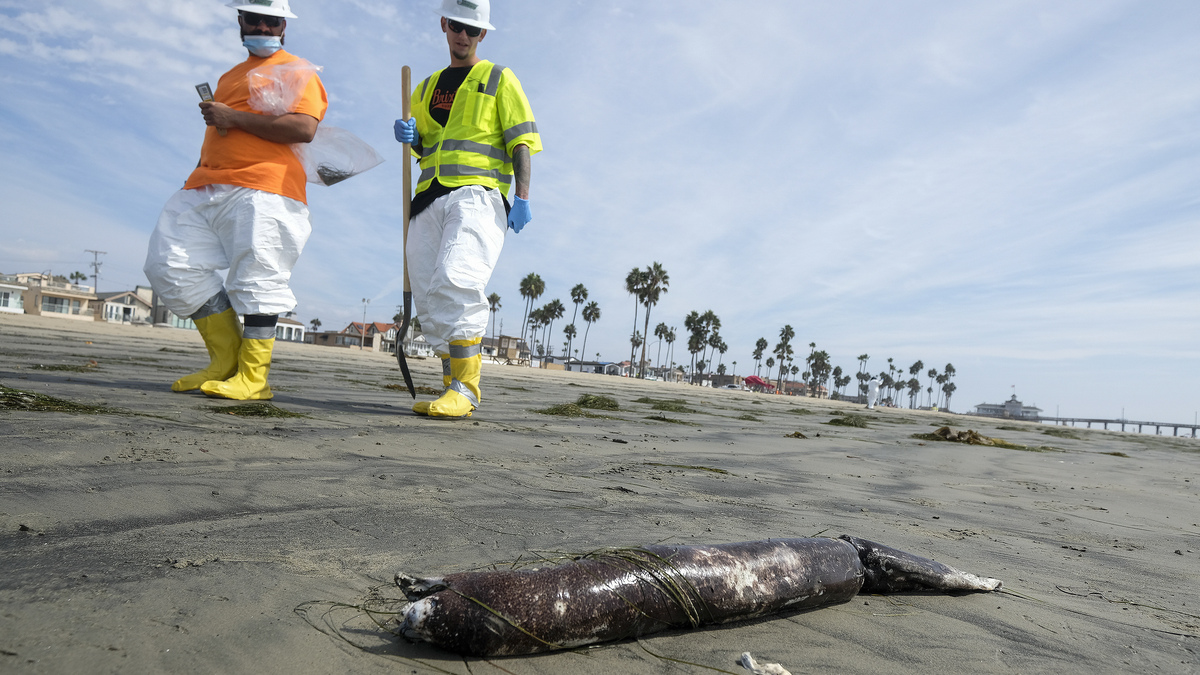
[ad_1]

Workers clean the contaminated beach in Newport Beach, Calif., after a major oil spill off the coast.
Ringo H.W. Chiu/AP
hide caption
toggle caption
Ringo H.W. Chiu/AP

Workers clean the contaminated beach in Newport Beach, Calif., after a major oil spill off the coast.
Ringo H.W. Chiu/AP
HUNTINGTON BEACH, Calif. — Video of the ruptured pipeline that spilled tens of thousands of gallons of crude oil off Southern California shows a thin crack along the top of the pipe that could indicate a slow leak that initially was difficult to detect, experts said Thursday.
The 13-inch-long narrow gash could explain why signs of an oil slick were seen Friday night but the spill eluded detection by the pipeline operator until Saturday morning, said Richard Kuprewicz, a private pipeline accident investigator and consultant.
“My experience suggests this would be a darned hard leak to remotely determine quickly,” Kuprewicz said. “An opening of this type, on a 17-mile-long underwater pipe is very hard to spot by remote indications. These crack-type releases are lower rate and can go for quite a while.”
When pipes experience a catastrophic failure the breach typically is much bigger, what’s referred to in the industry as a “fish mouth” rupture because it gapes wide like the mouth of a fish, he said.
Amplify Energy, a Houston-based company that owns and operates three offshore oil platforms and the pipeline south of Los Angeles, said it didn’t know there had been a spill until its workers detected an oil sheen on the water Saturday at 8:09 a.m.

Workers walk by as dead marine life washed up after the oil spill.
Ringo H.W. Chiu/AP
hide caption
toggle caption
Ringo H.W. Chiu/AP

Workers walk by as dead marine life washed up after the oil spill.
Ringo H.W. Chiu/AP
The cause of the spill is under investigation by numerous agencies as the cleanup continues along miles of shoreline on the Orange County coast south of the ports of Los Angeles and Long Beach.
The Coast Guard is investigating whether a ship’s anchor might have hooked and bent the pipeline. Amplify has said publicly that no more than 126,000 gallons leaked. But it also told federal investigators the total amount may only be 29,400 gallons.
Officials said Wednesday they were investigating whether a ship waiting to offload its cargo might have had something to do with the leak. Coast Guard investigators boarded the massive German-flagged container ship Rotterdam Express to determine if it was involved in the spill. The Rotterdam was the ship anchored closest to the pipeline last week.
Hapag-Lloyd, the shipping company that operates the vessel, confirmed Thursday that investigators boarded the ship while it was docked at the Port of Oakland in San Francisco Bay. The Coast Guard interviewed the captain and crew and was provided access to the logbook showing the ship’s locations, according to Nils Haupt, a spokesman at Hapag-Lloyd’s headquarters in Hamburg, Germany.
Afterward, the Coast Guard called the company to say the Rotterdam no longer was under scrutiny for the spill, Haupt said. The ship was cleared to depart Oakland was headed to Mexico.
The leak occurred about 5 miles offshore at a depth of about 98 feet, investigators said. A 4,000-foot section of the pipeline was dislodged 105 feet, bent back like the string on a bow, Amplify’s CEO Martyn Willsher has said.

People enjoy the beach in the background as workers clean the contaminated sand.
Ringo H.W. Chiu/AP
hide caption
toggle caption
Ringo H.W. Chiu/AP

People enjoy the beach in the background as workers clean the contaminated sand.
Ringo H.W. Chiu/AP
Questions remain about when the oil company knew it had a problem and delays in reporting the spill.
A foreign ship anchored in the waters off Huntington Beach reported to the Coast Guard that it saw a sheen longer than 2 miles just after 6 p.m. A satellite image shot by the European Space Agency indicated a likely oil slick in the area around 7 p.m. and was reported to the Coast Guard after 2 a.m. by the National Oceanic and Atmospheric Administration.
Federal pipeline safety regulators have put the time of the incident at 2:30 a.m. Saturday but say the company didn’t shut down the pipeline until 6:01 a.m. and didn’t report the leak to the Coast Guard until 9:07 a.m. Federal and state rules require immediate notification of spills.
The type of crack seen in the Coast Guard video is big enough to allow some oil to escape to potentially trigger the low pressure alarm, Kuprewicz said. But because the pipeline was operating under relatively low pressure, the control room operator may have simply dismissed the alarm because the pressure was not very high to begin, he said.
Ramanan Krishnamoorti, a petroleum engineering professor at the University of Houston, said the pipeline might have leaked for days before being discovered.
“If you have a massive crack or massive hole, you get a huge pressure drop and therefore you know you have a massive leak,” he said. “When you have a hairline crack like that, perhaps this could have been going on for two, three, four days.”
The fact that the San Pedro Bay line was still encased in concrete in the video is another indication that oil was likely leaking at a low rate. A major breach on a highly pressurized line would blow the concrete off, Kuprewicz said.
Because the line is encased in concrete — a means of keeping it weighted down on the sea floor — the Coast Guard video doesn’t reveal the condition of the half-inch-thick steel pipe underneath.
Once federal safety investigators cut out the damaged section of pipe and remove it, they will be able to conduct a closer examination, looking for signs of corrosion, metal fatigue or other anomalies that would have made it more susceptible to failure. That examination should also reveal if the crack grew larger over time, Kuprewicz said.
[ad_2]
Source link